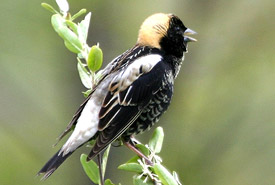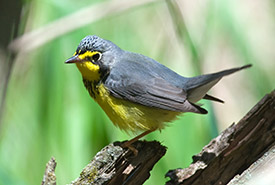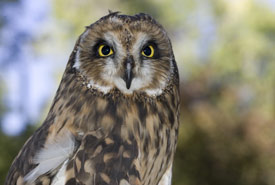Winter strategies for at-risk birds

Bobolink (Photo by Bill Hubick)
Now that I’m hunkered down for the cold winter season, I often find myself reminiscing about summer days and the colourful feathered friends that have long departed for warmer climates. Yearning for a trip somewhere warm, I wonder, what strategies do some species of at-risk birds use to deal with our infamous Canadian winters? These birds are worth admiring, and learning about their energetic endeavours will hopefully motivate you to pile on the layers and get outdoors. Let’s explore some of the strategies our birds use.
The bobolink is threatened across its breeding range in all of Canada’s provinces. They nest on or close to the ground in grasslands, including in hayfields. This makes them vulnerable to changes in the timing of agricultural practices, as occupied nests can be destroyed during cultivation. They spend the winter in Bolivia, Brazil, Paraguay and Argentina, and make a round-trip back to Canada, travelling up to 20,000 kilometres a year. This is one of the longest migrations of all songbirds in North America! The bobolink begins its journey in late July, making a stopover in the southern U.S. to molt. Molt is a science-y way of saying they change into more appropriate clothes...I mean feathers. Once they are all dapper, they continue their journey to the Pampas, a temperate grassland in South America. Sticking together in large flocks, they will move to different locations based on food availability. A trip to the Pampas sounds nice right about now, eating your way across South America…I digress.

Canada warbler (Photo by Gerald Deboer)
Canada warbler is listed as threatened in its breeding range, which includes all provinces and territories except for Nunavut and Newfoundland and Labrador. Overall, 85 per cent of the global breeding population is found in a variety of forest types across Canada. Even though they only spend two months of the year in Canada, a large number rely on Canadian habitat for their survival. Canada warblers winter in Central and South America in mature cloud rainforests, as well as second-growth forests and shade-grown coffee plantations. Habitat loss is a major threat in both their breeding and wintering grounds. Perhaps a brisk walk with some hot, shade-grown organic coffee may get you outside, if you can’t fly off to Panama for 10 months out of the year.

Short-eared owl (Photo by Gregory Johnston)
The last species I would like to highlight, short-eared owl, is a global species, yet Canadian populations are facing decline and they are listed as special concern. A highly nomadic species, they breed in every Canada province and territory. Like the bobolink, they need grasslands, but will also make use of Arctic tundra, taiga, bogs, marshes and old pastures. The limiting factor for their summer abodes is abundance of prey and vast areas of undisturbed habitat. A breeding pair needs up to 300 acres (121 hectares) to mate successfully — that’s the size of about 108 baseball diamonds! A hardy species, this owl will winter along Canada’s southern border, with others migrating to the U.S. and Mexico.
All of these species have complex ways of adapting to seasonal fluctuations in temperature and food abundance. Some will travel vast distances to get away from the cold, while others will hunker down where it’s a little less chilly. As strong as these birds are, they still need your help. All of them are at risk due to population declines linked to habitat loss. Volunteering or donating to organizations such as the Nature Conservancy of Canada is a great way to conserve species habitat for generations to come. If you have been inspired by these species to get outdoors, get involved and consider ways to keep them surviving.
This blog was supported by the Species at Risk Stewardship Fund.


